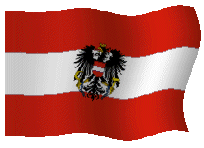
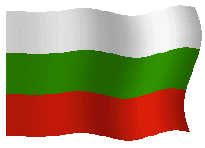
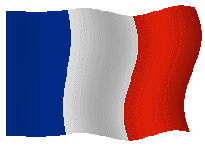
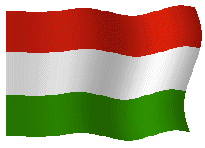


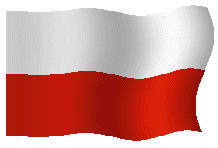
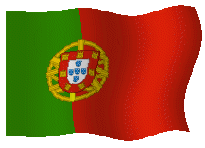
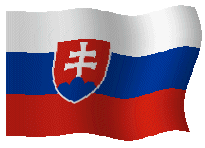
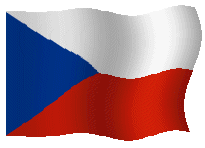

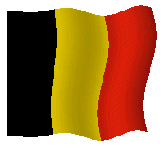


![]()







![]()



 NEWSLETTER 26
NEWSLETTER 26
January-July 2004
ALADIN Newsletter 26 ( pdf file)
CONTENTS
1.1.Events
1.1.1.A & AAA meetings in Prague
1.1.2.ALATNET : the end
1.1.3.Training course on ALADIN and NH dynamics
1.1.4.14th ALADIN-Workshop
1.1.5.Enhanced cooperation with the HIRLAM group
1.2.Announcements
1.2.1.Good bye ...
1.2.2.A new ALADIN website
1.2.3.Workshops, meetings and training courses in 2004
1.2.4.Next ...
1.2.5.Support to travels : “KIT” money
1.2.6. Aladin correspondents
1.3.ALADIN 2
1.4.Gossip
2.1.Introduction
2.2.Changes in the operational version of ARPEGE
2.3-2.16.In each center
3.1-3.14.In each center
4.1.Introduction
4.2.Radi AJJAJI : Incrementality deficiency in ARPEGE 4d-var assimilation scheme
4.5.Karim BERGAOUI : Further improvement of a simplified 2d variational soil water analysis
4.6.Vincent GUIDARD : Evaluation of assimilation cycles in a mesoscale limited-area model
4.8.Raluca RADU : Extensive study of the coupling problem for a high-resolution limited-area model
4.11.Klaus STADLBACHER : Systematic qualitative evaluation of high-resolution non-hydrostatic model
4.13.Malgorzata SZCZECH-GAJEWSKA : Use of IASI/AIRS observations over land.
4.14.Jozef VIVODA : Application of the predictor-corrector method to non-hydrostatic dynamics
5.1.Summary of answers to the LAMEPS questionnaire (HMS)
5.2.Preliminary results of LAMEPS experiments at the Hungarian Meteorological Service
5.3.Choice for radiance-bias correction for a limited-area model
5.4.Radar Reflectivity Data Assimilation
5.6.Some details about ALADIN physics in cycle 28T1
5.7.ALADIN and GMKPACK at ECMWF
5.8.Detailed case study of a dramatic winter temperature overestimation in the ALADIN/HU model
5.9.Subjective evaluation of different versions of the ALADIN/HU model 15
5.10.ALADIN-AUSTRIA : increasing the vertical resolution in ALADIN
5.11.First experiments with ALARO-10km
5.12.Limitations of projected limited-area spectral models for large-domains
On the 13th of February, just after the last
ALATNET meeting, the so-called « AAA » meeting
(AROME-ALARO-ALADIN)
was held in Prague. Discussions allowed to give some clarifications
on the interconnection of the three « A » and
also some guidelines to start working on ALADIN2.
See
http://www.cnrm.meteo.fr/aladin/meetings/AAA.html
for more details.
Exactly 2 months after the end of the ALATNET
project and as requested by the E.C., the ALATNET final report (see
photo) was flying to Brussels. The ALATNET website is fully
up-to-date now (including this last report on-line) ! Each ALATNET
centre will receive a paper copy of the final report with a CD
containing the full web site in its very last version. Many thanks
and congratulations to all participants to the ALATNET adventure
!!!
More informations on http://www.cnrm.meteo.fr/alatnet/.
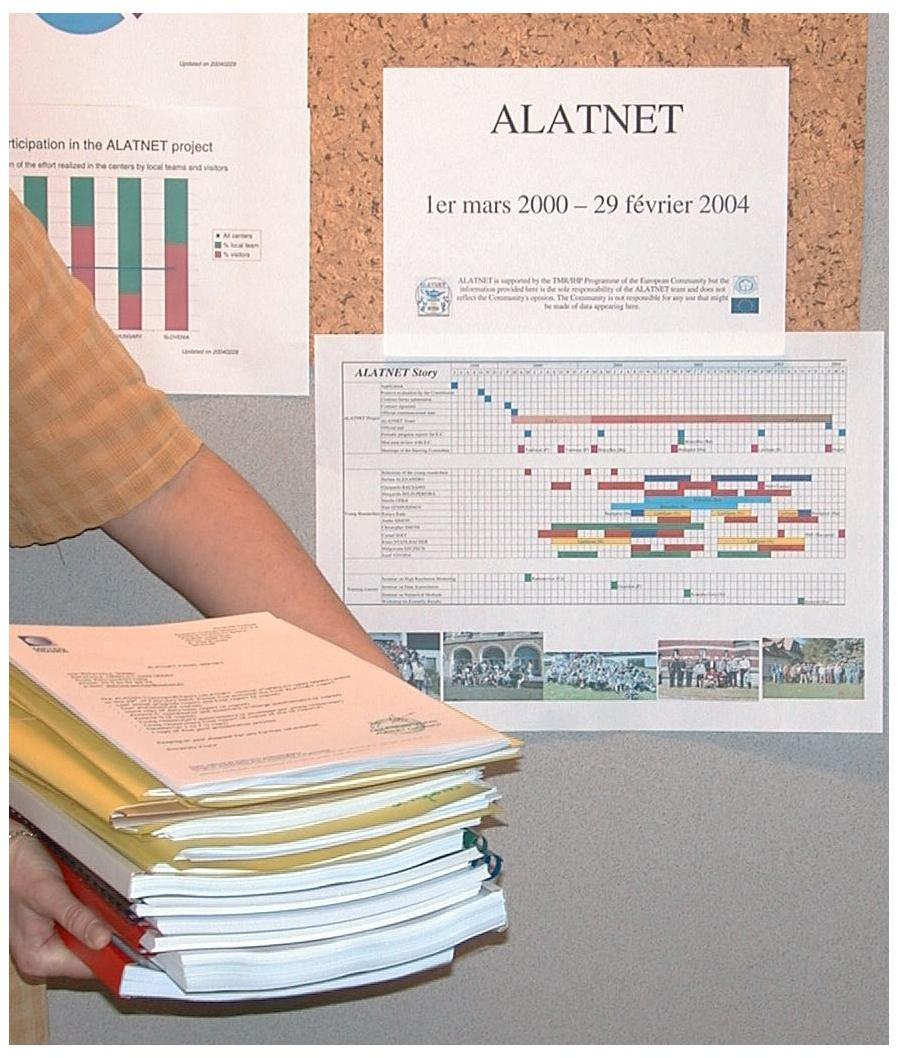
A training course on NH dynamics and the main
ALADIN features was organized in Toulouse on March 15-19, 2004.
Students were HIRLAM scientists and ALADIN newcomers. More
informations, including lectures and a few conclusions, are available
on-line :
http://www.cnrm.meteo.fr/aladin/meetings/NHtraining.html
The 14th ALADIN-Workshop, organised by ZAMG, was held from 1-4 June 2004 in Innsbruck, Austria. More than 50 colleagues from ALADIN countries and two HIRLAM scientists attended the workshop.
Most topics of interest for the ALADIN scientists and users were considered within the 43 presentations and 5 working groups. However more focus was given to critical ALADIN-2 topics, especially the main one "Which physics at which scales for limited-area models ?". Discussions on predictability issues, with most researchers meeting for the first time, were also quite successful.
More detailed information about the workshop, on-line presentations and reports from discussions, can be found under : http://www.zamg.ac.at/workshop2004/ .
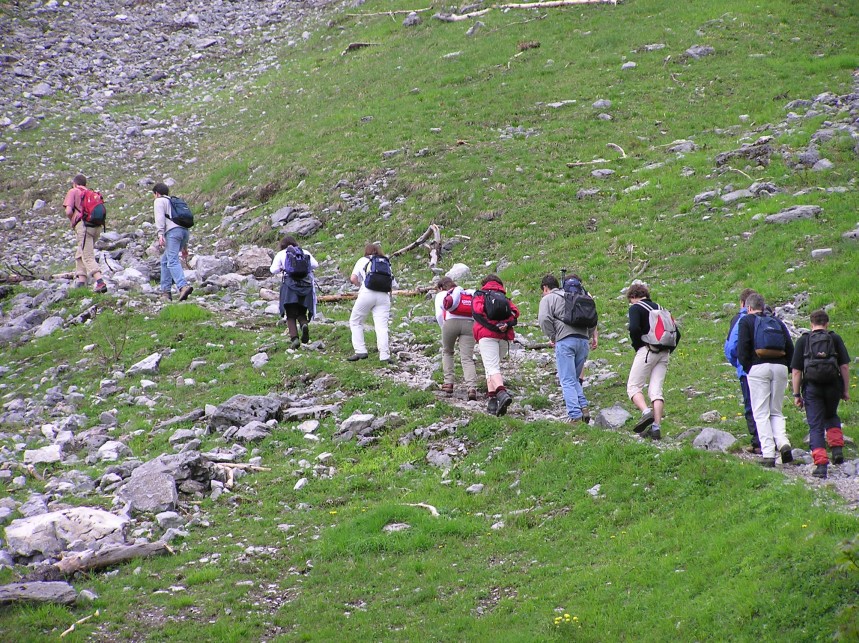 No rest for ALADINists
No rest for ALADINists
Congratulations to the organizer (Klaus, on the right)
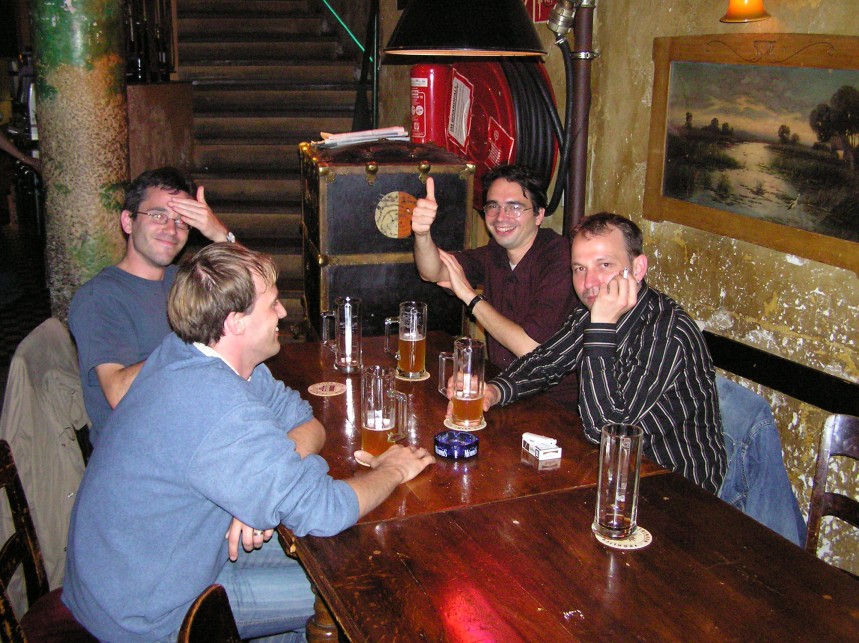
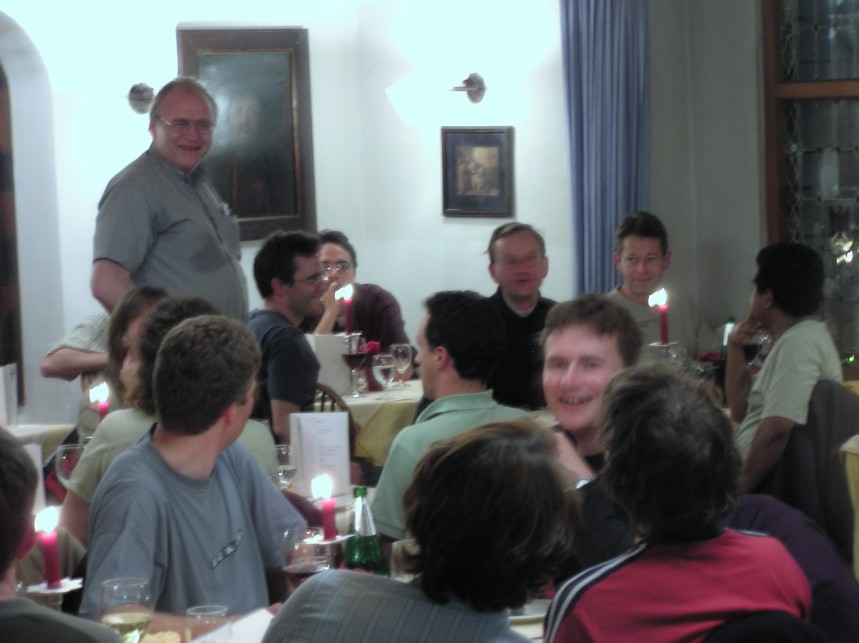 ALADIN-HIRLAM cooperation
ALADIN-HIRLAM cooperation
More pictures here.
The HIRLAM group has to face very similar challenges as the ALADIN one for the coming years : developing applications at very high resolution while simultaneously improving the forecast skill at the present operational scales and limiting maintenance burden, with contributions from several but rather small NWP teams.
So they now considerer a move towards AROME for their kilometric-scale target application, this also meaning a far closer cooperation with ALADIN, with going towards the same model, i.e. the ALARO package including the main HIRLAM specificities, for use at all scales. The diplomatic aspects of the cooperation require however a clearer definition, and will be jointly examined at the next HIRLAM Advisory Committee and Council, and at the Assembly of ALADIN Partners.
But collaboration in research mode has been already effective for years, and intensive training of HIRLAM scientists on ALADIN has now started. We had a few ALADIN scientists knowing how to run HIRLAM, the reverse is now true ! And some specific actions, such as the design of a suitable ALADIN geometry for the very large HIRLAM domains, or the plug-in of HIRLAM physics in ALADIN (for preliminary comparisons) are on the way.
The HIRLAM deputy leader for high-resolution modelling, Bent Hansen Sass (DMI, bhs++at++dmi.dk) and the project leader, Per Unden (SMHI, per.unden++at++smhi.se), are the main contact points.
An important change happened in the leadership of the NWP team at the Hungarian Meteorological Service. Gabor Radnoti (now gabor.radnoti++at++ecmwf.int) joined the ECMWF team for a 2-years job. He is the fourth ALADIN scientist leaving for Reading, after Martin, Marta and Vanda. His successor at HMS is Sandor Kertesz.
Philippe Caille (alias Touffe), the famous specialist of observations and coffee breaks, left the GMAP team for a more "communication" oriented position.
Alfred Quinet, the head of the Belgian team, retired. He significantly contributed to the project's life, having Belgium enter the ALADIN partnership and the ALATNET project, and contributing to the refinement of the Memorandum of Understanding and to the definition of the role and scope of ALADIN-NORAF.
After long months of cleaning and porting under open softwares, a newly updated ALADIN web site is available, with the following innovations:
ALADIN Newsletters
The last joined ALADIN/ALATNET Newsletter (ALADIN 25, ALATNET 8) is available through 2 pdf files (the smaller one for on-line consulting and the bigger one for better quality printing). An improved presentation and paper copies should be available soon.
Please consult the new guidelines for contributions to the next Newsletters.
ALADIN ... (ALARO - ALADIN-2) ... AROME ! : first ALADIN-2 web pages
A website will be dedicated to the new ALADIN-2
actions once the new host Linux PC will be available. Meanwhile, the
relevant informations on will be available through :
http://www.cnrm.meteo.fr/aladin/aladin2.html.
A
specialized AROME site will be designed too.
More documentation is now available
e.g. the two last reports from stays, a documentation on the porting on AL26T1 on IBM, information on the prototypes, and the developers' bedside reading : "New coding rules for ARPEGE/IFS/ALADIN".
News mailing lists and presentation of addresses in the web site,
as a protection against "spam" ... See the "News" page on the ALADIN site !
ECMWF Seminar on Recent developments in
numerical methods for atmosphere and ocean modelling (6-10
September, Reading, UK)
The SRNWP workshop on Numerical
Techniques will be consequently delayed by one year.
Fourth Joint SRNWP/HIRLAM Workshop on Surface Processes and Assimilation of Surface Variables (15-17 September, Norrköping, Sweden).
COSMO General Meeting (22-24 September ,
Milano, Italy).
Dijana Klaric will attend it as ALADIN
representative.
26th EWGLAM and 11th SRNWP meetings (4-7
October, Oslo, Norway).
The special topic is "High
Resolution Modelling in Mountainous Regions" and a half-day
session will be devoted to MAP.
Informations at
http://www.met.no/EWGLAM_2004.
WGSIP/WGNE/WGCM Workshop on Ensemble Methods (18-21 October, Exeter, UK).
9th Assembly of ALADIN Partners (29-30
October, Split, Croatia).
ALADIN-2, the HIRLAM-ALADIN
cooperation, and the renewal of the MoU will be the "hot"
topics of this extended Assembly (with the participation of
scientists).
Joint SRNWP/Met' Office/HIRLAM workshop on Variational Assimilation (15-17 November, Exeter, UK).
Mixed Training course / Working
group on physics-dynamics interface (22-26 November, Prague,
Cz).
For informations, contact jean-francois.geleyn++at++chmi.cz.
Fourth WMO International Symposium on
Assimilation of Observations in Meteorology and Oceanography (18-22
April 2005, Prague, Czech Republic).
More informations on :
http://www.chmi.cz/dasympos/index.html
15th ALADIN Workshop, Spring 2005, in Bratislava, Slovakia.
16th ALADIN Workshop, Spring 2006, in Sofia, Bulgaria
27th EWGLAM &12th SRNWP meetings, Autumn 2005, in Slovenia.
Assembly and (hopefully) signing of a brand
new MoU, November 2005, Bratislava, Slovakia.
Do not hesitate to have a look at the "Meetings" pages of the ALADIN web site or at the SRNWP web site : http://srnwp.cscs.ch/
This Météo-France funding supports coordination visits, e.g. to enable "all" ALADIN countries to be represented at the annual ALADIN or EWGLAM workshops.
Concertation meetings are of growing importance in the framework of an enhanced decentralization of research, but have to face a severe lack of fundings in some institutes.
On August 16th, these
funding had been used or were scheduled for :
- 7 participations
to the ALADIN workshop,
- 8 participations to the EWGLAM
workshop,
- 3 or 4 participations to the SRNWP-Var workshop
-
2 to 4 participations to the Assembly of Partners,
- 3
participations to the Prague workshop.
On average, this corresponds to 2 or 3 travels per partner in 2004.
Participation registration: in order to make easier the http interface tool, some no longer “active” people and fundings have been removed from the proposed list. Of course, all the data concerning these people and fundings are kept in the data base. The criteria to define a not “active” person are a mixture of conditions on the date of the last registered action, the number of actions and other information received in Toulouse about changes in the teams. Please, let me know if you want some one to be added to the list or to be be removed from it.
The statistics have been updated with all contributions at the end of March 2004 and new graphics are available. As soon as all contributions for the second quarter are registered, statistics will be updated again.
The coordala email was first created for ALADIN correspondents (i.e. Persons responsible of the participations) at the rate of 1 correspondent per country. It is now used for exchanges between scientists in charge, representatives and correspondents in all countries. Therefore the list of addresses in coordala has been extended accordingly. Just a reminder, in order to avoid spam when one sends a message to coordala, this message is only received by Eric and Patricia who then re send it to a similar list (obviously if it is a spam, then it is not sent).
The last months were fruitful for the ALADIN2 project. On the 13th of February, the so-called « AAA » meeting (Arome-Alaro-Aladin) was held in Prague. This meeting was the opportunity to give some clarifications on the interconnexion of the three « A » and also some guidelines to start working on ALADIN2. See, http://www.cnrm.meteo.fr/aladin/meetings/AAA.html for more details.
Following this meeting, a work plan for the year 2004 and early 2005 has been written that plans the work and developments inside ALADIN2. The organization is built around five sub-projects. Some of them are devoted to specific horizontal scales: AROME-2 (AROME nominal resolution, i.e. 2,5 km where the convection is resolved explicitly), ALARO-5 (also called the grey-zone where the convection is not fully resolved) and ALARO-10 (for regional scales around 10 km where a parametrization of the convection is needed).
The others sub-projects are transversal ones: INTERFACES (flexibility, exchanges between models and physical packages), ALAROPAC (for assimilation, predictability and coupling) and ALAD1 (operations). One can see http://www.cnrm.meteo.fr/aladin/scientific/2004-program.html to get the work plan on line.
The implications of this important preliminary definition and organizational work could have been felt during the Innsbrück meeting all along the working groups, presentations and discussions. One practical aspect of the WP04 is also the possibility to have a glance at the (very) first AA prototypes on-line: http://www.cnrm.meteo.fr/aladin/aladin2/prototype.html.
The bend towards AROME is now taken, hopping that the road will bring us many scientific challenges and forecast improvements.
Besides the usual coordination team, 2 persons were appointed for specific support actions to ALADIN-2. Maria Derkova (Sk) is responsible for the coordination of the upgrade of operational suites. Bart Catry (Be) is in charge of the design of an improved physics-dynamics interface, a key task with the diversification of physical packages (from 1 to 3, not counting the native Méso-NH one, or more).
Thanks to the new rules, the use of Open Office,
the careful design of style-sheets and links by Jean Maziejewski, and
more consideration from contributors, the present Newsletter will be
ready within a reasonable delay !
(roughly 1 month work for 2
Newsletters instead of 2 months for 1 this summer)
Please do not forget to send informations on the main operational changes to Patricia Pottier (patricia.pottier++at++meteo.fr) so that she may update the corresponding pages on the ALADIN web site !
(more details joel.stein++at++meteo.fr)
(more details thomas.haiden++at++zamg.ac.at )
Since May 2004 ALADIN-AUSTRIA has been put into operational use at ZAMG. Its main features are : LACE domain, 9.6 km resolution in horizontal, 45 levels in vertical. Both the ALADIN-LACE and the ALADIN-VIENNA models do not run operationally any more. More details about ALADIN-AUSTRIA are in the dedicated paper.
(more details alex.deckmyn++at++oma.be)
(more details andrey.bogatchev++at++meteo.bg )
(more details ivateks++at++cirus.dhz.hr, tudor++at++cirus.dhz.hr)
No changes along the last months. See the report on research and developments (§3.4) for details on verification and case studies.
(more details filip.vana++at++chmi.cz )
(more details joel.stein++at++meteo.fr)
Same model changes for ALADIN-France as for ARPEGE (§2.2).
(more details kertesz.s++at++met.hu)
In the operational suite of the ALADIN model, there were no changes in the first part of 2004.
Beside the operational model version, in parallel
suite the following versions were integrated and compared (see the
article of Helga Toth (5.8) on
the subjective evaluation of the ALADIN model):
a)
ALADIN dynamical adaptation at 12 km resolution
b) ALADIN
3D-Var at 12 km resolution
It is noted here that an invitation to tender
(ITT) was initiated to upgrade our computer system. Three companies
were applying to the tender : HP, SGI and IBM. The final decision was
in favour of IBM with the following system :
IBM p655 cluster
server 4 * 8 processors (1,7 Ghz) with
2 Gbyte/processor memory.
The initial capacity of the new
(highly expandable) system will be approximately 1,5 times bigger
than the already existing Regatta system.
(more details ajjaji++at++marocmeteo.ma)
(more details zijerczy++at++cyf-kr.pl)
Nothing new.
(more details margarida.belo++at++meteo.pt)
During the first half of 2004 some effort was put on the installation of ALADIN on a new machine, making possible the increase of the coupling frequency and the number of vertical levels, besides the increase of the local domain. In addition, significant attention was given to the objective verification of ALADIN products and to its comparison with ECMWF forecasts. Moreover, after a validation period, some instability indexes (Jefferson, Total-Totals and Convective Instability) computed from ALADIN forecasts became pre-operational. Other diagnostic tools, such as low-level moisture convergence, vorticity advection and temperature advection, became also pre-operational. Finally, the validation of CANARI is going on.
(more details doina.banciu++at++meteo.inmh.ro)
The switch to new coupling files (larger domain and 41 vertical levels instead of 31) for the SELAM domain (covering the Bulgarian and Romanian ones) was prepared by Cornel Soci. This is part of a general upgrade of the operational suite, which will be described in the next Newsletter.
(more details oldrich.spaniel++at++shmu.sk)
The main event during the first half of 2004 was related to delivering, installation and operational tuning of the new high performance computing system IBM @server pSeries 690, Typ 7040 Model 681, 32 processors POWER 4+ 1,7 GHz , 32 GB RAM of memory, IBM FASt T600 Storage Server + EXP700 – 1,5TB.
The operational suite is expected from the
beginning of July with the following parameters:
- code version
AL25T2
- domain 320×288
points
- horizontal resolution 9.0 km
- 37 vertical levels
-
time step 400 s
- 48 hours forecast, twice per day
- dynamical
adaptation.
The operational suite has been completely overwritten with respect to the on-line monitoring and documentation tool that has been developed in house. This tool is based on Perl script and the internal web interface. The pre-operational suite has been launched for 1 month with emphasis on testing the queuing and batch system. A complete output result from post-processing is expected 1 hour after receiving LBC files from Toulouse.
(more details neva.pristov++at++rzs-hm.si)
During the first half of 2004 nothing changed in the operational suite except including some additional products in the output for our users. Computation of products for PEPS project and for RODOS match and lsmc modules was prepared but not yet put into operation.
(more details nmiri++at++meteo.nat.tn )
Moving to cycle 26T1_op4 : see the R&D report (§3.14).
Local work was dedicated to the organization of
the 14th ALADIN workshop :
http://www.zamg.ac.at/workshop2004/
and
the implementation of a new operational
suite.
See the report on operations (improvement of the verification and diagnostics packages).
Local work focussed on the implementation of the operational suite on the new computer. See the report on operations
A ALADIN new doctor since April 20th : Cornel
Soci (second ALATNET doctor)
Research topic : Sensitivity
study at high resolution using a limited-area model and its adjoint
for the mesoscale range
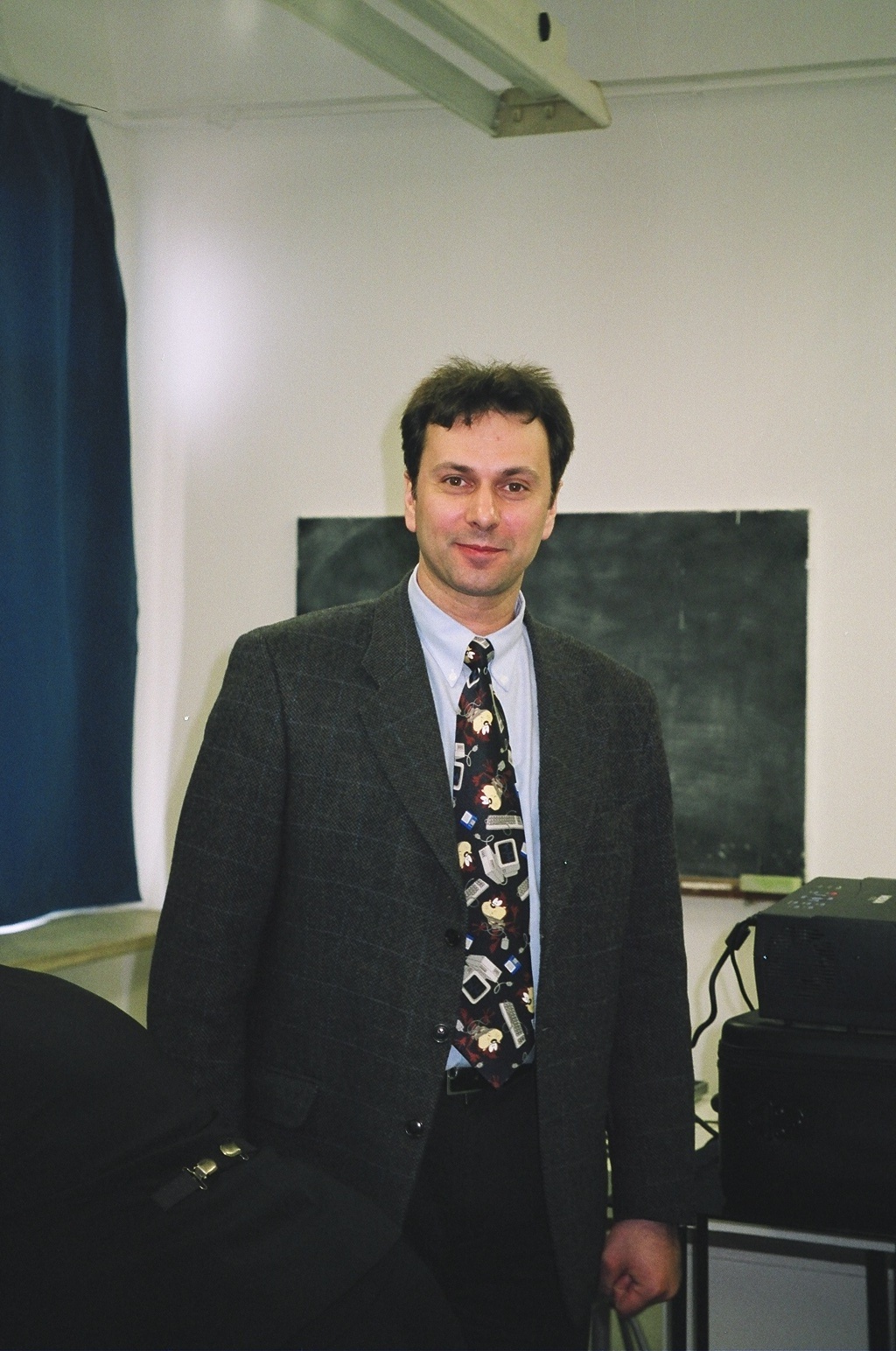
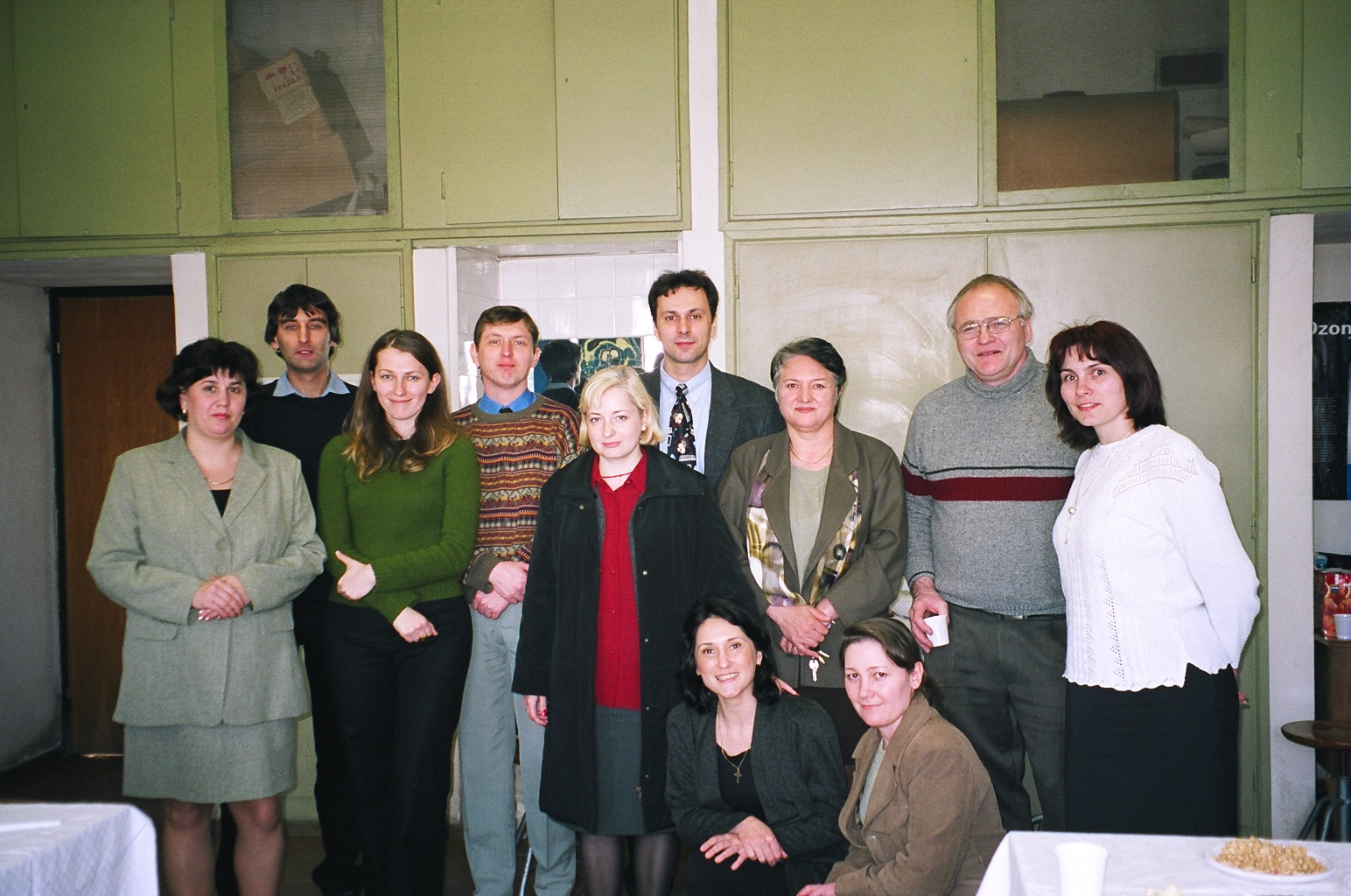
Operational duties at home (see part 3.11), and starting writing an article.
A method based on an ensemble of analysis has been tested and evaluated in ARPEGE 4D-Var. The global and local covariances have been diagnosed, and compared with those of the NMC method. Moreover, some impact studies have been performed in the ARPEGE 4D-Var, with respect to the global background error covariances, and also concerning the local background error variances. It was verified that the use of the "ensemble" statistics has a positive impact on the forecasts of non-stretched ARPEGE. A publication about these results is under preparation.
Then operational duties at home (see e.g. the proceedings of the 14th ALADIN workshop).
Work on the ELDAS project.
Bibliography of convection: Emanuel, Mapes, Yano, Arakawa, ...
Work on the manuscript.
Work on lateral entrainment of deep convective clouds, and its link with environmental moisture. Deal with CRM data to get this sensitivity of entrainment to environmental moisture.
Extensive validation of the new method : see the Romanian contribution to research and developments (§3.11) .
The PhD manuscript is almost ready.
Nothing new (operational duties at home).
Nothing new (operational and administrative duties at home, including the organization of the 14th ALADIN workshop : http://www.zamg.ac.at/workshop2004/).
During this period, the validation of the emissivity database for infra-red sounders was evaluated with AIRS data. Results confirm prior results with HIRS : for surface-peaking channels, the use of the new emissivity values slightly improves the agreement between observations and model values with respect to the standard 0.98 value. A very preliminary draft of a paper has been written.
2004: A simplified bi-dimensional variational analysis of soil moisture from screen-level observations in a mesoscale numerical weather-prediction model.Q.J.R.M.S. Vol.130 Part A n° 598, pp 895-915. http://www.royalmetsoc.org/
Abstract: The analysis of soil moisture for the initialization of a mesoscale numerical weather-prediction (NWP) model is considered subject to operational constraints, both in terms of computational cost and data availability. A variational technique is used to analyse the soil moisture by assimilating screen-level observations of temperature and relative humidity. We consider a simplified bi-dimensional (z and t) variational approach (simplified 2D-VAR), where the estimate of the observation operator is obtained from extra integration(s) of the numerical model. The fundamental assumptions of the method are first evaluated: linearity of the observation operator, horizontal decoupling between grid points, and truncation of the control variable space (variable decoupling), that allow the simplified 2D formalism. Thus, the variational method is applied at each grid point separately and the gain matrix is computed from finite differences given the small dimension involved. The 2D-VAR technique keeps count of the full physics of the model, so the corrections applied to the control variable are adapted to the current meteorological conditions and the grid-point characteristics (texture and vegetation), as well as to the previous soil state. The linear estimate of the observation operator is studied in detail to optimize its evaluation. The validation of the method is shown with simulated observations, and the assimilation of real observations is performed with different time-windows. A sequential assimilation cycle on a 6-hour time-window allows the comparison with the optimum interpolation technique, while a 24-hour window is considered to extend the temporal consistency of the assimilated observations in the analysis. Results from the performed analyses with the simplified 2D-VAR method show a good retrieval of soil moisture, and a comparison with other initialization methods is also provided.
2004: An efficient approximation of the Malkmus band-model average equivalent width for the case of the Voigt line-profile. Q.J.R.M.S., vol.130 Part X no. 598, pp xxx-xxx. http://www.royalmetsoc.org/